This can often be what a Drainage Engineer does day to day on any given week. Some love it, some put up with it, some would rather being doing the more complicated, technical works or maybe just surveying all day long.
But I found going around doing reactive jobs would keep Engineers sharp. You’ve got problem solving, a puzzle to solve, a challenge to defeat, and so on…
If you’re here reading this, chances are you have a blocked drain in front of you, or keep getting blocked drains and want a permanent fix.
A lot of this guide may seem obvious, but I’ve laid it out for anyone from any background to understand, and quite often when people are stressed or overwhelmed in this situation, clear, simple & obvious helps.
These guides may not help with your specific problems, but it should aid in you assessing, diagnosing and tackling the blockage and help you understand how clear, how to prevent, and enable you to solve your drainage issues in a no nonsense, cost effective way.
These guides may not help with your specific problems, but it should aid in you assessing, diagnosing and tackling the blockage and help you understand how clear, how to prevent, and enable you to solve your drainage issues in a no nonsense, cost effective way.
For ideas on what could be causing your drainage issue, check out Common Causes of Blocked Drains
Let’s Start with the Drainage Problem…
Something isn’t working how it should and it’s causing you problems. Let’s break it down to its components.
A drain is quite an open, generic term when used in this context. I would say if you have a blocked drain, it could be a blocked pipe in the property, or a blocked manhole or inspection chamber outside the property (but not always, there are plenty of internal inspection chambers for a variety of reasons).
So let’s assume what you’re dealing with is a blocked “drain” which is causing a toilet, sink or other facility to drain slowly; or there could be a leak or smell, or any combination.
I’m going to assume here that you’ve got a slow draining toilet or sink, but whatever it is, the same process can be followed.
Zoom out and Look at the Bigger Picture
Let’s say you have a sink that’s slow to drain in a bathroom with a sink, toilet and bath/shower.
Physics tells us that water always finds the lowest level, which is why ordinarily your waste water will behave itself and flow away and out of sight, running through into deeper and deeper drains until it reaches the sewage treatment works which could be many miles away.
But not this time, this time it’s staying put in your sink.
What’s near the sink? A sink plughole is always higher than both the toilet bowl and bath or shower plughole.
So, if your sink isn’t running but your toilet and bath are getting away as normal, you can very likely work out the blockage is between the sink and where all the facilities join together in the SVP, or soil vent pipe, or stack, or whatever name people often call it.
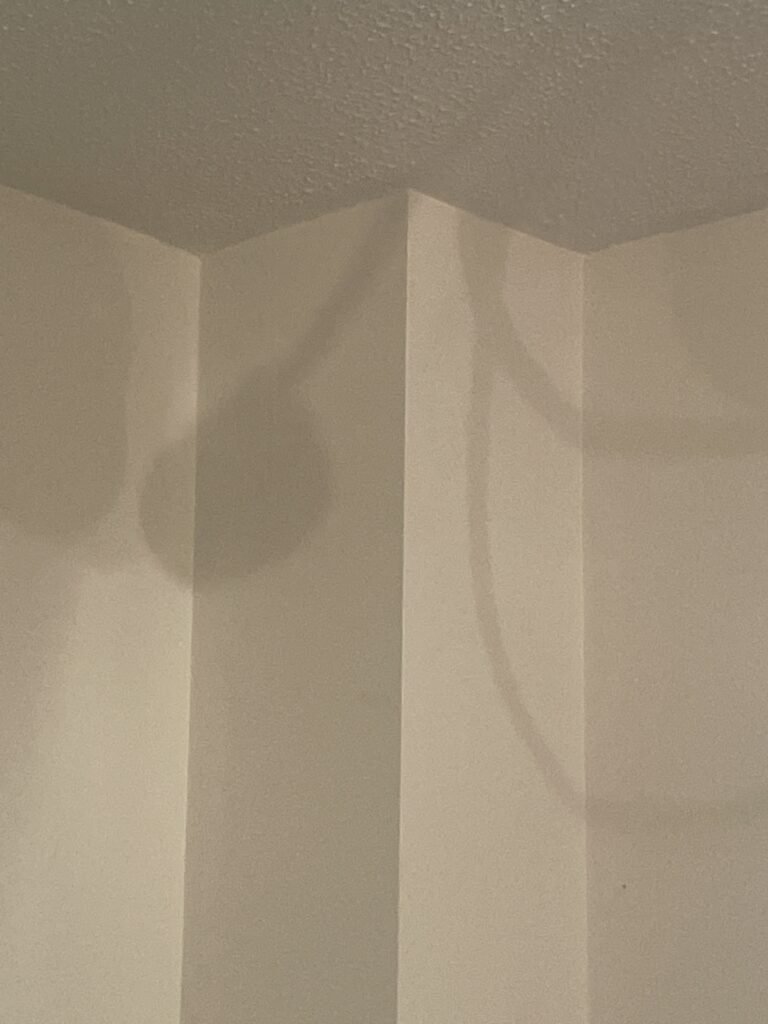
The soil vent pipe is usually a 100mm (4″) grey UPVC pipe, but could be cast depending on the age of the property. It isn’t likely to be visible, but often the boxing or cladding around it gives it away.
If you’re on the ground floor, the blockage could well be underground inside or outside the property.
We’ll first assume your blockage is internal, within the property; if you already know the blockage is outside, feel free to skip ahead!
Now Zoom in and Work out a Plan of Attack
Now, depending on what’s actually affected, you can work out access points and how to deal with the blockage.
If you think the blockage is localised to an individual facility such as toilet, sink or bath, I would go for a tool like below:
My Go-To For Most Internal Blockages
The Rothenberger RoPump, or Kinetic Ram as I’ve always known it, has defeated hundreds of blockages for me over the years, from simple pop & go’s to the most stubborn bank of a dozen toilets.
This versatile and simple drainage tool leaves very little mess and is one of the most simple to use!
These can be anywhere between £70-£100 but will easily pay for themselves if they prevent you having to cash out for a drainage contractor; especially if you need to use it on more than one occasion.
Sometimes, the Rothenberger will clear more than one facility depending on where the blockage is and other factors such as distance.
If you don’t have the budget for this, or time to have it delivered, a simple plunger on the end of a rod will suffice – but it may just be a bit messier!
Can’t clear from the toilet, sink or bath/shower?
If this first step hasn’t worked, or everything is affected, the next step needs careful consideration as opening the wrong access point or from too low could cause an uncontrollable mess.
Access points. Rodding Caps. Openings and Removable Pipe Fittings. All Options Now!
Now we need to consider where the water level is, which will in turn give us a good idea of where the blockage could be.
If you have any access points you know of, and they are above the water level, you can safely open them and clear the blockage from above.
If you can’t open an access from above and you’re concerned about opening a charged, or full pipe, you can reduce the amount of water in the system by either waiting it out and letting the water seep past the blockage, or use a wet vac to empty from the most convenient place. You’re very unlikely to be able remove all the water from the system, but this will make a massive difference to potential mess if you can suck out any water.
Where to Dispose of the Waste Water?

If we’re dealing with an internal blockage, and you find an inspection or manhole chamber outside ( but still on your property), this is a perfect place to empty your wet vac, whether it’s one load or many.
Just make sure it’s a foul, or waste manhole and not a rain water or surface water manhole – you can see from the image here that this is clearly a foul manhole, but also testing other facilities and confirming it runs to here is a good confirmation.
Now either you have an access point above the water level, or you’ve removed as much water as possible and about to tackle the blockage.
If you’re not used to this kind of problem, I would suggest checking you have the kinds of things listed below to hand; this helps with the grotty bits and to help clear up after. You may not need some of it, but it’s worth considering:
Checklist for Unblocking an Internal Drain
🧤Disposable Gloves
- Ordinarily, I’m all for reducing waste but in this case, it’s much easier and cleaner to simply remove and dispose of latex (or similar) gloves once they become too grubby to use, or for handling things when trying to reducing cross contamination – especially in an emergency!
Sheeting, Tape & Bin Bags
- Preparation is key with blocked drains, if you think there’s a risk of flooding or mess, you should prepare plastic sheeting around the likely messy area and carefully use tape if you’re covering walls and heavy furniture, etc.
- Bin bags should be readily available regardless of if you think a mess will be made, just for quickly disposing of used gloves and placing used equipment inside until you can take it outside and clean it off.
Paper Towel, Disposable Wipes and Disinfectant
- Seems obvious, but make sure you have paper towel, or disposable towels, wipes, etc. to hand so you can quickly clear any excess water or mess up during and after you’ve unblocked the drain.
Drain Dye
- Drain Dye has to be one of the most underrated tools available to anybody dealing with drains. Cheap and versatile, this will quickly allow you to both trace a pipe or drain, and confirm you’ve cleared the blockage. In my experience, green is the best colour as it shows most easily, especially in deep chambers and low light.

Now the fun part. You have traced the blockage, you have the closest point of access open and you’re ready to attack it.
The majority of blockages don’t need elaborate kit or expensive equipment, let’s start out with a basic set of rods or flexible cable. If the blockage is internal and you’re close, it likely just needs persuading to move.
When clearing a blockage like this, let’s say by using rods or a flexible stick of some kind, you should feel some resistance when you hit the blockage.
If you have a water level below the access point, using a plunger will push the water toward the blockage, encouraging it to move; usually at this point once the blockage has moved or broken up, it will move freely and the blockage is cleared (depending on the cause and layout of your drainage system).
Once cleared, you should see the water level drop and usually hear a “gasp” of air as the water drains away, allowing air to flow freely through the pipes again.
What if the Blockage is Outside?
Two things here: Sometimes the blockage is outside, underground, and sometimes secondary blockages occur where they start out inside but then get stuck again; this is more common when things like fat, grease, scale and wipes are involved.
Before we worry about unblocking your drain, it’s worth checking who’s actually responsible, financially and legally, as it could be cleared by a Water Authority (free of charge) under certain conditions.
Drain Responsibility in the UK
Things changed in 2011…
It used to be you were responsible and your neighbours were responsible right until the drain hit the public sewer in the road; but now it’s clear cut and worth checking for your own piece of mind!
It’s worth noting here that it doesn’t matter who the property belongs to, if the drain serves two or more properties and joins a public or main sewer, it’s the water board’s responsibility.

Example Water Authorities



Now, assuming you find yourself responsible, let’s move on to the next section.
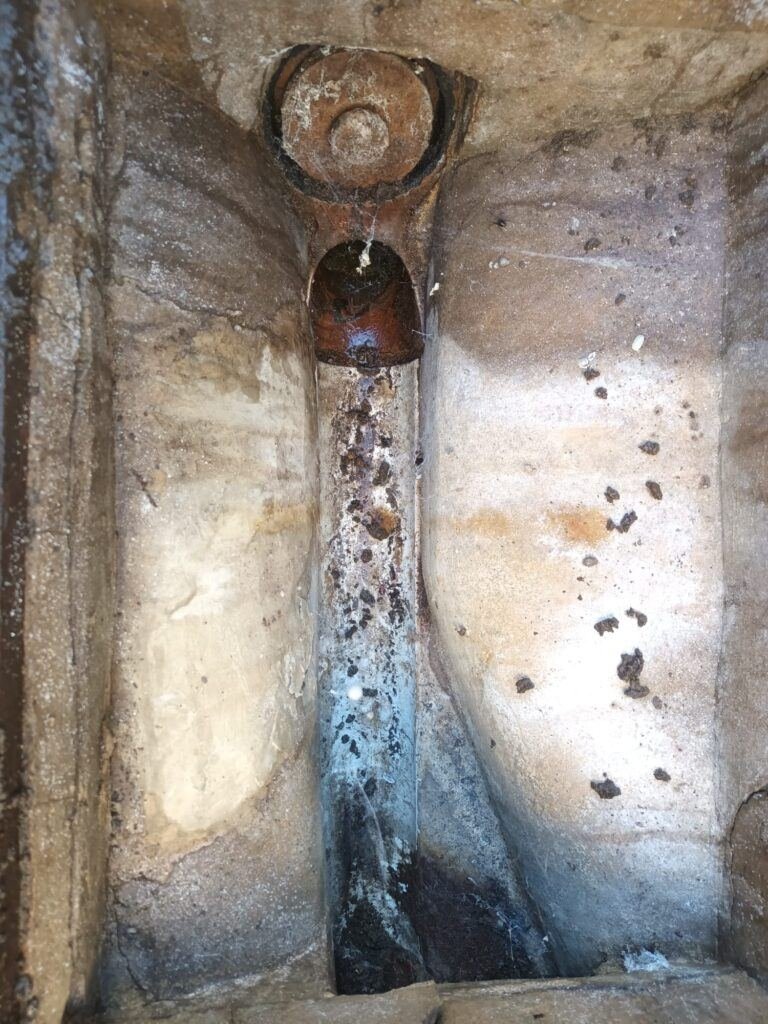
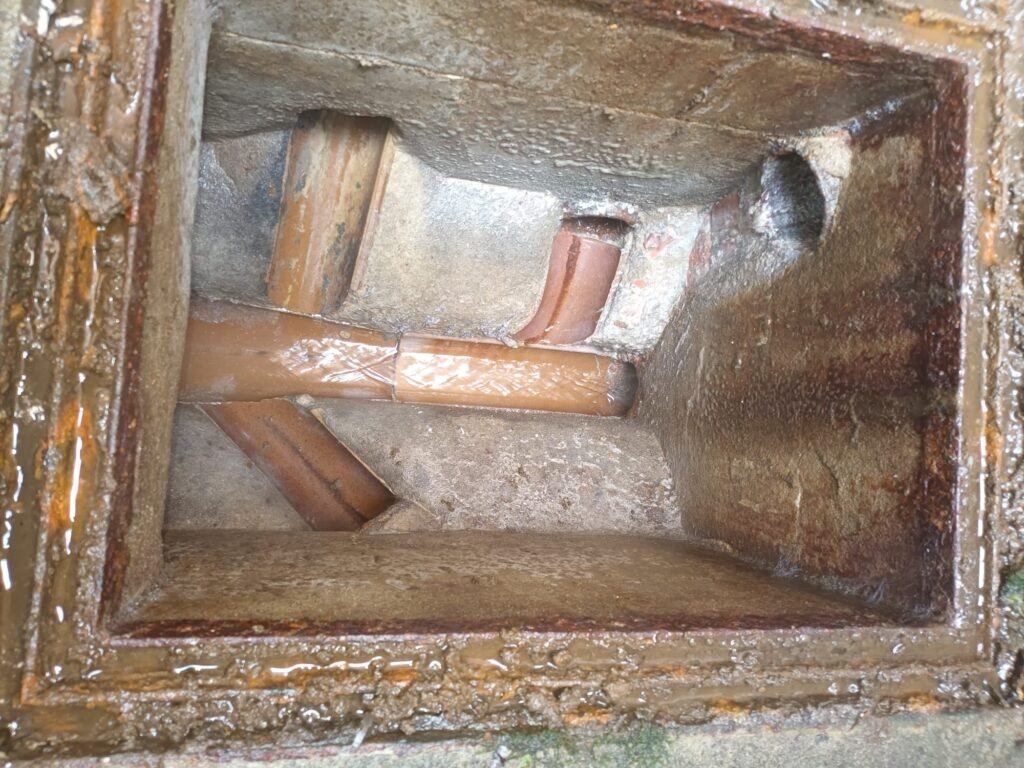
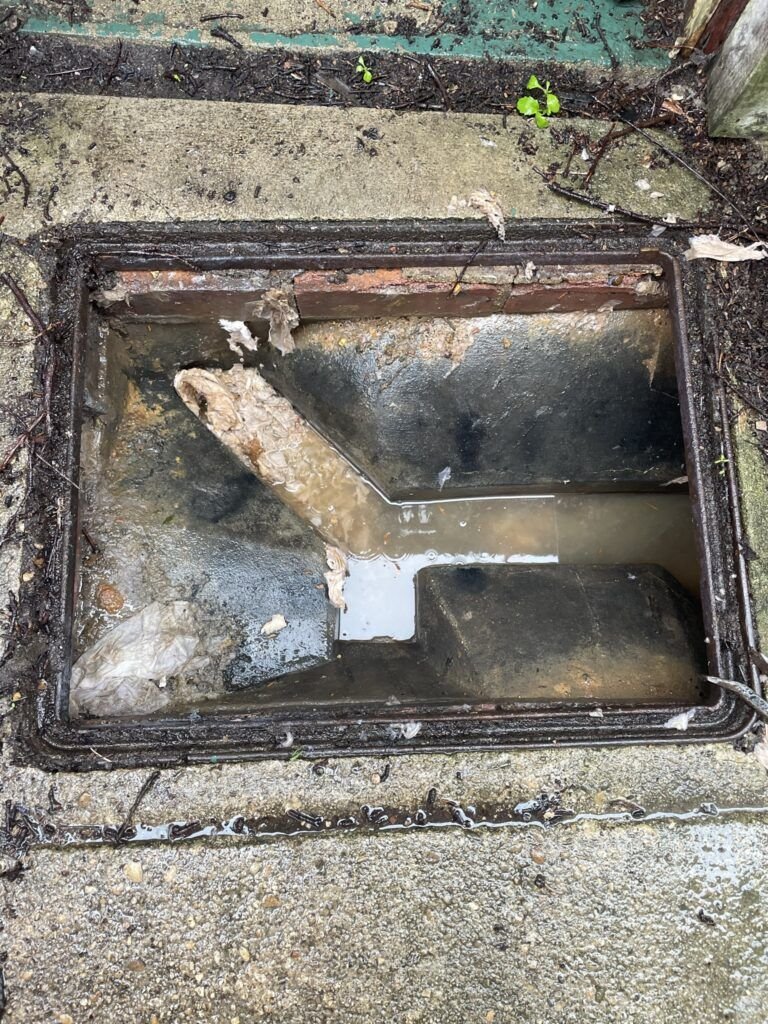
If you find your external drains are also affected, we follow the same process as inside the property – I often found external blockages to be easier to deal with as it’s almost always underground and you’re not dealing with charged, vertical waste pipes. And if they do overflow, they’re outside anyway and easier to clean up.

As you can see here (excuse my attempt at graphic design), the drains follow a route from the back of the property to the front. If you have a manhole or inspection chamber that’s full and any that are clear, the blockage will be between them.
It could be right in the middle, or anywhere between the exit of the full one and the inlet of the clear one.
Options? Plunge from the full end, or use rods without a plunger from either end.
There are several options to choose from here, depending on your individual problem.
You could try just plunging until you’ve had a workout, or if plunging doesn’t work, use blank rods or a “pig’s tail” attachment, and try to clear from the full or empty end. The empty end, or clear manhole, may be easier to go from as you can see the pipework.
When using rods, make sure they are fully tightened before using them to unblock a drain!
Just like with an internal blockage, when you push against the water with a plunger, or use a blank rod, you should feel resistance when you’re near the blockage and once persuaded, the water behind it should go quite quickly.
If you find yourself defeated by the blockage, it could be time to call a professional; in which case it’s worth bearing the following in mind:
Calling and Dealing with a Professional Drainage Company
- Whether a local company or national brand, make sure you clarify the costs upfront.
- A common misunderstanding is whether the price includes or excludes VAT. Make sure this is understood as it could mean you spending an extra 20% if it wasn’t made clear.
- Ask if the call out cost or first hour includes HPWJ or mechanical machines if needed; I found this to be a common gimmick with companies coming out “cheaper” on the face of it, but then build the price up when they’re there and dealing with the problem. You may want to go with the more expensive option if they clearly use what’s available to them and don’t take advantage of your situation…
- Ask around. Depending on your location, costs vary wildly, but getting two or three options should give you an idea of what the average price is for your area.
- Check Google reviews, TrustPilot, etc for reviews and even social media. Their customers will give an honest impression and they encourage reviews, then chances are they’re genuinely good.
- Don’t give in to pressure if a drainage contractor “scares” you into remedial works – for example they clear a blockage, check the pipe with a camera (good practice as it encourages piece of mind and helps guarantee the clearance) and tell you they can line or patch it for X amount of £’s, or they need to do a rootcut, degrease, etc. Bear in mind factors such as:
- Is this is a first time or infrequent problem? Then there’s no rush. Assess the situation and tell them you’ll think on it.
- Have you seen the footage? Verify the findings and ask to be sent a recording if possible.
- Are you being pressured in the moment? This can unfortunately be a scare tactic to easily upsell, especially toward customers who aren’t technical and may be vulnerable.
- Don’t be afraid to say you’ll check with your family and friends, especially if huge costs are involved.
There are many local and large drainage companies in the UK, and whilst the majority are hard working, honest outfits, the above points should be considered as there will always be a minority of cowboys out there.
You may also like
Hopefully this has helped, more “Engineer’s Guide to…” posts will be added in time, and if anything here needs clarifying further or you’re struggling with a drainage issue like this, feel free to leave a comment below or email us!
info@drainhub.uk | tony@drainhub.uk


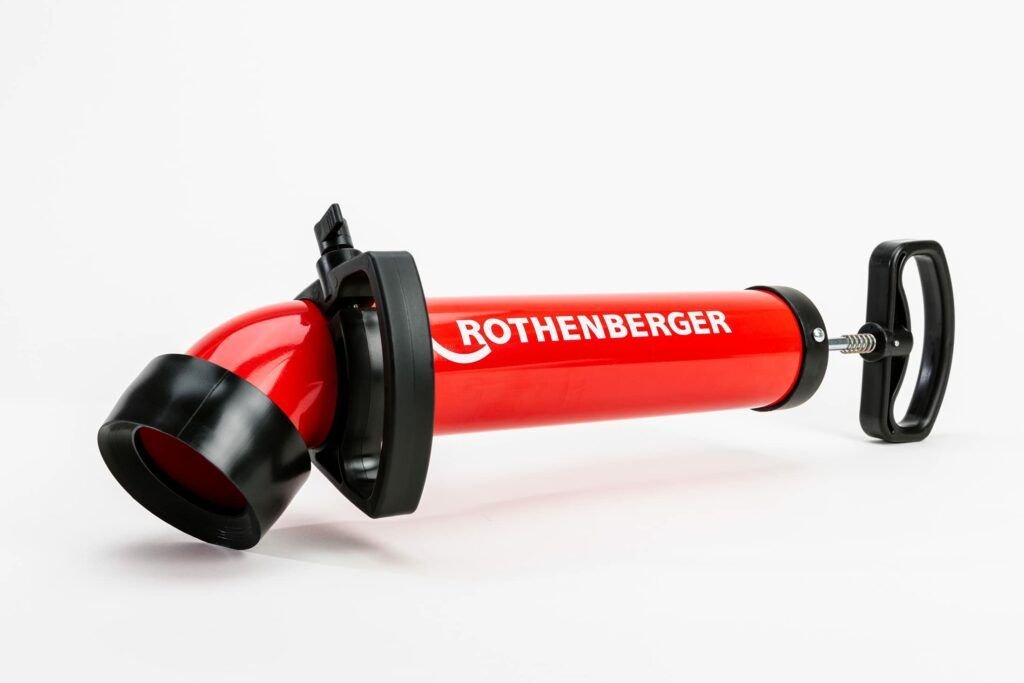
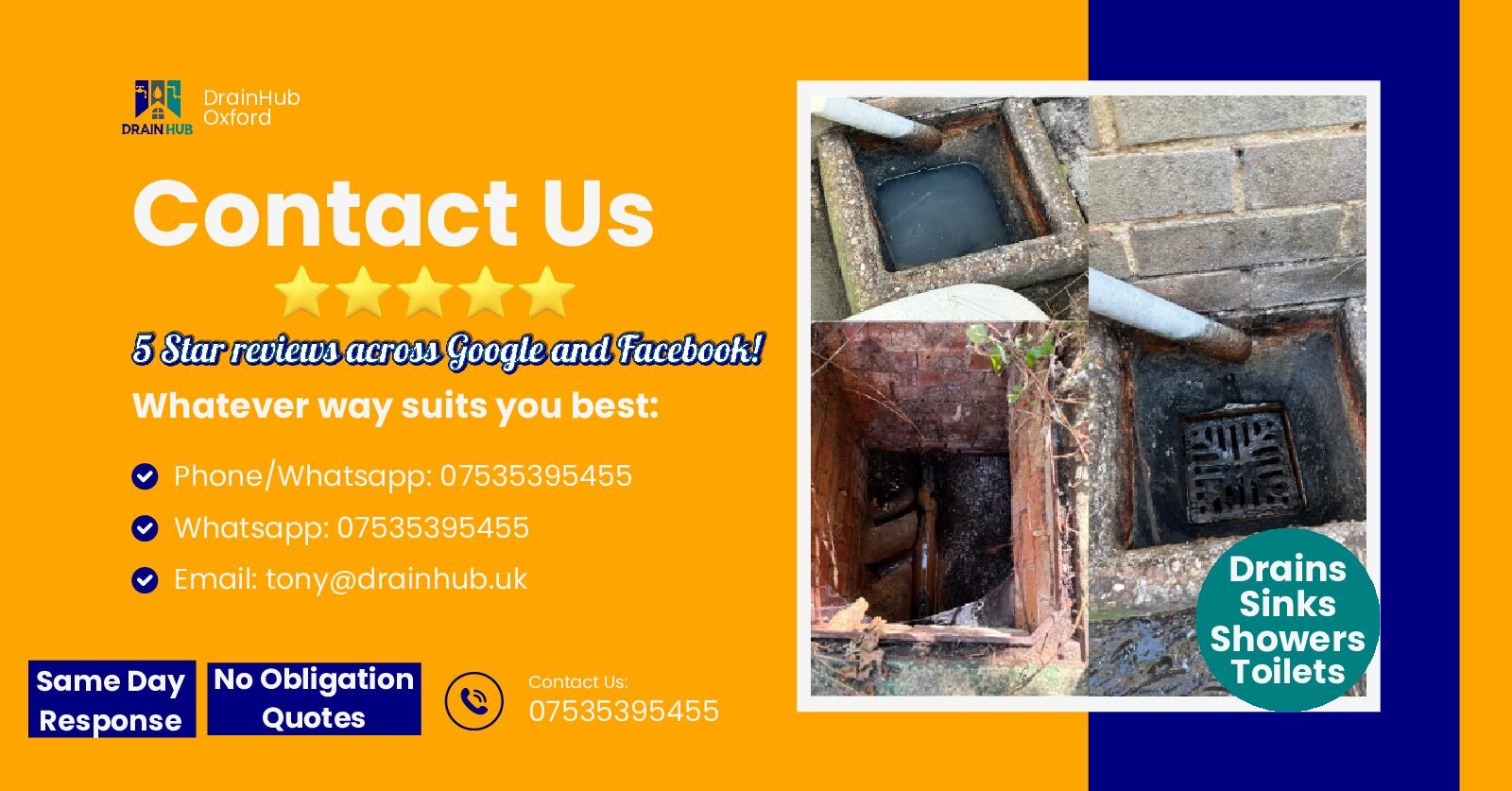
Leave a Reply